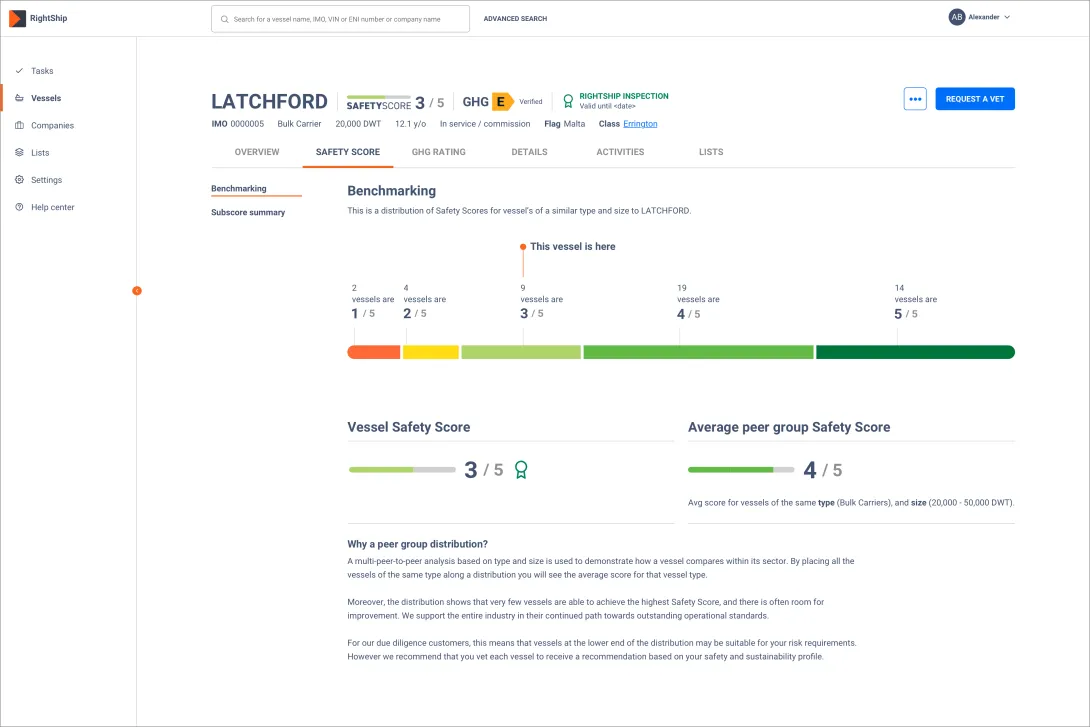In this article, Martin Crawford-Brunt, RightShip CEO, explains how we’ve further enhanced our Safety Score after launching in beta and outlines the rules and model calculations that we analyse to generate vessel scores.
In mid-2020, after undertaking a significant product development effort to deliver on customer needs , RightShip opened its beta Platform and Safety Score with a view to collect industry feedback and ensure we were creating the best possible product for our customers and the ship-owning community.
The new developments for our Safety Score are a result of listening to that feedback from ship owners, charterers, ports and terminals. We thank those who took the time to make a contribution, as we aim to support every part of the supply chain and provide due diligence services and actionable solutions for those seeking to improve safety standards.
With this feedback in mind, we have made some changes to improve your experience. The fundamentals of the Safety Score remain the same, but we have added some important distinctions to improve clarity and have also bolstered our governance process.
Rules vs model – at a glance
The most important shift is the additional minimum standard binary rules that trigger automatic results of a Safety Score NA, zero, 1 and 2. If no rules are triggered, or the triggers are resolved by the ship-owner, the vessel can then be assessed by the Safety Score model and achieve a score between 3 and 5.
Safety Score Rules (Safety Score of N/A, zero, 1 and 2)
As part of our initial Safety Score process, we focus on binary rules that are based on good industry practice. This is the initial risk assessment for customers at the beginning of their due diligence process, before vetting takes place.
These rules inform an absolute minimum standard that vessels must meet. Where these rules are not met, they may result in a score of zero, 1 or 2.
When triggered, each rule requires a definitive resolution process, with each scenario needing clear actions which can release the vessel from a low score.
Vessels may trigger multiple rules. In this case, the lowest rule score must be resolved before the vessel can move to a higher score. For example, if a vessel triggers a SS1 rule and a SS2 rule, the SS1 rule will need to be resolved before a score of 2 can be achieved. In turn, once the SS2 rule is resolved, the vessel may move to a score of 3 or higher.
Safety Score Model (Safety Scores of 3, 4 and 5)
Once all of the Safety Score rules have been resolved, or in the event that no rules were triggered, the vessel’s Safety Score will be calculated within the Safety Score model and will result in a score between 3 to 5.
The model is made up of six sub-scores and more than 20 safety considerations that provide indications of the vessel’s five-year historical safety performance.
Risk factors are considered at the vessel, DOC, Class and Flag level. The output is a score between three and five. A vessel that has achieved a 5 out of 5 indicates consistent safety performance over the last five years.
The result is a model focused on clear performance indicators that operators can proactively improve. They can see the sub-scores that need work and benchmark their safety against the best performers.
What’s new for vetting customers?
First, a reminder that the Safety Score is an initial check prior to vetting a vessel. Charterers, ports and terminals may use it as the first step in their due diligence process.
In addition, we have made automatic trigger rules clearer. That means results spanning from zero, 1 and 2 will be clearly identified, with vessel owners needing to complete specific steps in order to resolve the trigger item and move forward to model analysis. In certain cases, this will include multiple levels of manual review of the submitted information by two Operations staff to confirm that there have been meaningful improvements in safety operations on this vessel or within the vessel management. This ensures that vessels are scored correctly and that the Safety Scores of 3 – 5 highlights those with a commitment to transparency and best practise operations.
In our methodology, we have clearly outlined how customers can use the Safety Score as an initial input into their due diligence process. Once a vessel has been selected, we recommend completing the process with the relevant inspection, sustainability and vetting checks to provide confidence it is an appropriate choice for a voyage or cargo type.
What’s new for ship owners?
We have provided clearer guidance on possible actions to help ship owners improve safety performance that resolves rule triggers and continues their path to best practice in operational safety.
The Safety Score provides an indicator, and the score should be considered in conjunction with delivery of consistent health and safety management practices, inspections and corrective actions to address deficiencies, and consistent vessel safety performance over time.
At each stage in the Safety Score process, owners and operators can see where they need to improve their score and take action.
The updated Safety Score is now open to review in our beta Platform. To learn more about our Safety Score, read the methodology or view our educational videos. If you would like more information, please contact info@rightship.com
